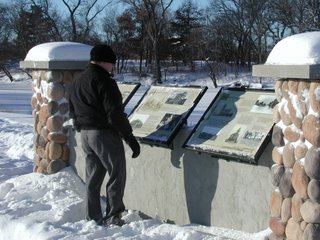
Grand Portage National Monument, located within the boreal forest on the north shore of Lake Superior in northeastern Minnesota, preserves a vital center of fur trade activity and Anishinaabeg Ojibwe heritage.
The Grand Portage itself is a footpath which bypasses a set of waterfalls on the Pigeon River a few miles from where that stream runs into Lake Superior. This path is part of the historic trade route of the voyageurs between their wintering grounds and their depots to the east. This route, comprised of the Pigeon River and other waterways and Grand Portage and many other portages, was of enormous importance in pre-industrial times, as it provided access from the Canada's settled areas to its interior of Canada. Some 50 miles upstream from Lake Superior, this trade route crosses the Height of Land Portage connecting South Lake on the Pigeon River watershed with North Lake of the Rainy River watershed. This portage crosses the Northern Continental divide and therefore provides passage between the drainage basin of the Arctic Ocean and that of the Great Lakes and Saint Lawrence River to the Atlantic Ocean. - Wikipedia
That is a real brief background of Grand Portage National Monument a place I have visited 7 times in the last 13 years. I would of made it all 13 if I was still in state, that is how much I enjoy this historical place.
There are a number of things I like about this National Monument and the first two have nothing to do with it. The weather up on the “north shore” of Minnesota is absolutely fantastic. That alone is worth visiting. In the summer time the temps rarely hit 85 degrees and the over night lows are in the 50’s. The air is filled with the scent of pine and it is so crisp and refreshing that you want to bottle it up and take it home. To get to the “north shore” takes about 2 hours from Duluth and about 5 hours from Minneapolis. There are plenty of great places to stay along the shore and the further north you go the closer you obviously get to the Grand Portage. Cities like Tofte, Lutsen, Grand Marias all have fine resorts and bed and breakfasts to stay at. You can even stay at Grand Portage, the Grand Portage Band of Ojibwe Indians have a casino and a very modern hotel.
Now back to the real reason to visit; Grand Portage Monument entry fee is 3.00 for adult and 6.00 for family. You pay by the honor system at the main entrance to the fort. Once you are in you can either go into the great hall or visit the kitchen. Historical reenactors greet you at each building offering tours and small talk. Depending on the time of the year they will talk about what would be actually happening at the fort at that time. When I was there this past August the cook was exhausted because he had cooked a number of meals for the grand rendezvous which had happened that weekend. This rendezvous is the culmination of a years worth of fur trapping. The fur traders from 150+ fur outposts meet at Grand Portage to load and ship their goods to Sault Ste. Marie and from there to Europe. The cook had all kinds of information about the traders, what they ate, what they did for entertainment, where they were from, and tales from the deep inside the wilderness of present day Canada and the United Stes.
In the Grand Hall you get a tour of the eating area, storage, and offices. There is also a gift shop which has a number of excellent books on the early fur trader, Indian history and culture, and historical prints. You also get some interesting trivia from the guides, for instance there were teas from as far away as China being used at Grand Portage in the early 1700’s. Personally I found that incredible that out in the middle of this wilderness these traders could still have imported tea from the far east.
After visiting the Great Hall you can either go out to the grounds and walk to other building sites which are marked by foundations but no longer stand. You can also go down through the lake gate to the dock and take in the beauty of Lake Superior. From there you can make your way up a trail to the Ojibwe village where historical actors are demonstrating daily life from grinding grain, stitching canoes, or drying hides. West of the village is the canoe shop where a historical actor is building canoes in a 17th century style assembly line. When I was there the actor was actually living the life he was portraying and was filled with knowledge of the fur trade, indian relations at the time, and the politics of competing fur companies. I found him most valuable during my tour.
You can tour the grounds your self using the self guide or you can go on guided tour by one of the actors. I suggest for first time visitors to take these guided tours since a lot of the questions you may have will be answered and you won’t miss anything. After the tour take some time to get into the moment by walking the grounds, visiting with the Indians and actors, smelling the air, feeling the cool breeze of the lake, and if you are adventurous take the hike on the Grand Portage trail which is a 8.5 mile hike up the Pigeon river past the highest falls in Minnesota to Ft. Charlotte.
 Grand Portage National Monument
Grand Portage National MonumentIf you are in north shore area this stop is well worth your time not only do you get to take in a piece of early American life but you get to experience the the very best in nature.
Here are some helpful links.
http://www.grandportage.com/
http://www.nps.gov/grpo
http://www.dnr.state.mn.us/state_parks/grand_portage/index.html

